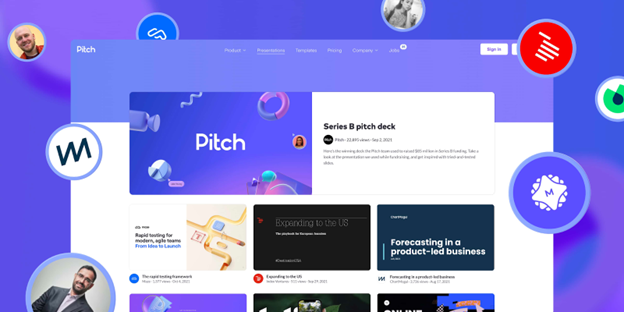What’s that one common trait you would find in almost all successful marketers?
All of them possess exceptional presentation skills.
It’s not easy to expose yourself to communicate more and present your thoughts and ideas in a room full of people.
However, like it or not, presentations are an integral part of marketing.
Strong presentation skills pretty much underline every aspect of marketing. That’s what makes potential clients trust your vision and eventually seal the deal. And that also helps create brand awareness.
Remember how effectively Steve Jobs brought forth his Apple products to the world, thus creating a brand that’s instantly recognizable and relatable.
Since presentations are considered the most potent weapons when it comes to selling a product, we’re here to help you find out what works and what doesn’t.
9 Techniques for improving digital marketing presentations
According to studies, 70% of American employees believe the ability to give power packed presentations is a crucial factor for finding success at work.
It’s always a little daunting to communicate your points effectively while putting together a slide deck and ensuring the audience is engaged.
The most common way of gauging a presentation’s impact is by analyzing the response of clients.
If they’re unresponsive or simply bored, chances are you won’t be hearing back from them once the presentation is over. It’s highly unlikely they’ll engage with your organization in the near future.
As a presenter, you need to learn from past blunders. Study your audience carefully.
Are they showing interest? Are they learning forward or taking notes?
We’ve listed down nine ways of creating better digital marketing presentations.
1. Tell stories
For your audience to engage with your presentation, it’s imperative to establish a strong sense of connection with them.
Rather than starting off with a lengthy introduction, begin with a story.
A story that would seamlessly blend into the current topic, thereby serving as a memorable opening strategy.
Spruce up your presentation by weaving personal stories wherever you can.
What’s the end goal of your presentation? What can the audience learn?
Tap into the emotional intelligence of your audience and add stories that’ll resonate with people’s emotions and get them listening. Even the most boring presentations come to life when they’re backed by stories of specific experiences.
2. Do not over clutter

“Perhaps too much of everything is as bad as too little.” ~ Edna Ferber
Too much clutter amounts to a bad presentation design.
Almost all presentation templates for professionals follow a minimalist yet effective approach that sticks to a particular design aesthetic instead of being all over the place.
Your text, templates, images should be placed in a manner that maintains synchronization with other slides. Whether it is your font style, the placement of the images, the color scheme or the overall layout – there ought to be a common theme running across all the slides.
An efficient way to avoid clutter would be to weed out those slides that you could do without.
These slides add nothing to the presentation. On the contrary, they create unnecessary distraction. The quicker you identify such slides, the better will be your prospects at the presentation.
3. Focus on three key points
We often tend to bombard our presentation with too much information which may be beyond the scope of the topic at hand.
Most of the time, the audience finds it hard to retain so much of it by the end of the session.
It might be tempting to cram everything into one presentation, but this strategy hardly ever works.
Focus on three main points and design your presentation in a way that revolves around communicating these points. Seek assistance from relevant texts, data points, visuals, gifs, stories to highlight these three points. The audience won’t feel too overwhelmed when the presentation is streamlined to specific points.
Try this and see how the attention span of your audience increases manifold at your next speech.
4. Don’t try too hard to sell
Sure, it’s a digital marketing presentation and in all probability, you have something to sell. This may be a part of your agenda but not necessarily the only purpose of your presentation.
Say a big NO to self-promotions or trying to sell your products and services during the presentation. This could be a huge turn-off for the audience who may feel let down by your constant urge to sell.
Focus on educating and informing the audience.
Share meaningful information that in a way promotes your business but also highlights important points that can act as major takeaways for the audience.
It’s when they realize you have an agenda beyond buying and selling that they’ll begin to invest in your business in the long term.
5. Let visuals do the talking
PowerPoint presentations are essentially meant to be a visual medium, conveying information and offering fresh perspectives in a visually enticing manner.
Instead of filling up your slides with boring texts, fill them up with images, graphs, gifs, memes that put forward your points without any words. That explains why infographics are a powerful medium of communication.
We’re visual creatures, our eyes are naturally drawn to images and we’re more likely to retain information this way.
Dedicate your time to pick out unique, visually stimulating, superior-quality high-resolution images for your presentation.
You can utilize some funny memes floating all over the internet to drive home your point while tickling a funny bone or two of your audience.
A lengthy paragraph may not convey your thoughts as efficiently as that witty image does!
6. Talk about real-life data
You know why most people have queued up for your presentation? It’s not because they want to know more about you or your opinion about a particular topic. They’re attending the session to know what unique perspective you are offering based on hard facts and logical analysis.
What makes your presentation stand out is the extensive research you’ve carried out and the data you’ve collected that’ll back your explanations.
Share relevant case studies and real-life examples to make your point.
Hard marketing data attracts the audience way more than simple generalizations and hollow claims.
Share charts, graphs and excerpts from interviews with industry experts to add credibility to your statements.
7. Inject well-meaning humor
“A sense of humor is a major defense against minor troubles.” ~ Mignon McLaughlin
This holds true in all walks of life, including marketing presentations.
Even if your presentation isn’t top-notch or is failing to generate a buzz, try to inject humor into the content and see how an average presentation turns out to be an instant hit with the audience. However, crass jokes or jokes that are completely off the track won’t work. Instead, create humor around the current topic.
You can add slides with pop-culture references or use anecdotes from your favorite sitcom to lighten the mood of your audience. This will create an easy connection while ensuring the audience stays hooked to your presentation.
In order to nail the comic timing in your presentation, you need to be confident and enthusiastic about the content.
8. Come up with “actionable” takeaways
The audience responds best to actionable content.
What’s the point in learning about new, fascinating data if it cannot be used to your advantage?
Implementation is the key. Great presentations don’t just discuss problems, they offer ways to solve them.
Ensure your presentation provides a series of clear, actionable, easy-to-implement instructions that’ll help identify and fix the problem areas.
It’s only when you start discussing solutions that people actually start taking note of the presentation. However, don’t just come up with vague solutions just for the sake of it.
Gain a thorough understanding of the topic and evaluate the merits of the solutions before passing them on to your audience.
9. Learn to listen
Sometimes we’re too obsessed with our presentation to be able to pay heed to genuine feedback.
Negative feedback is painful. But that’s the only way to learn and evolve. You must be open to criticism and shouldn’t shy away from making adjustments and alterations if the situation demands so.
Let your colleagues and seniors review the presentation. Maybe they can suggest something you might have missed. This way, you’ll gain valuable insight regarding what works, what’s distracting or avoidable and what falls flat.
Consult them, assess their viewpoints and be flexible enough to make necessary changes before you go up on stage for the presentation.
Conclusion
Digital marketing presentations are a tricky affair.
You never know what strikes a chord with your audience.
Instead of blindly emulating others, it would serve you best to develop your own distinct style that would compliment your personality and effectively utilize your strengths.
Before wrapping up the whole affair, distribute your contact information so that the interested parties can contact you.
Follow up with a targeted email campaign once the event is over.
Such an exchange of business cards and flow of emails would ensure you’re well on your way towards establishing a long-term association with the audience.
 Author bio
Author bio
Atreyee Chowdhury works full-time as a Content Manager with a Fortune 1 retail giant. She is passionate about writing and helped many small and medium-scale businesses achieve their content marketing goals with her carefully crafted and compelling content. She loves to read, travel, and experiment with different cuisines in her free time. You can follow her on LinkedIn.










